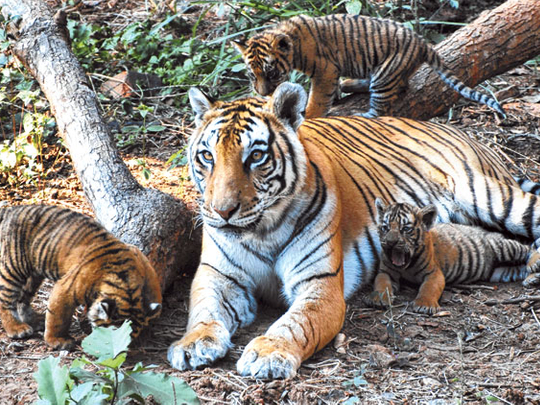
New Delhi: India has 1,706 tigers in the wild, marking an increase of 295 in the big cat's numbers, according to a census report released on Monday.
But Environment Minister Jairam Ramesh called the findings a mixed bag as tiger occupancy area had shrunk by nearly 22 per cent due to poaching and development.
The Sundarbans mangrove forests have been included in the census for the first time, with 70 tigers in the area. The rest of the country now has 1,636 tigers, marking an increase of 12 per cent over the 2006 figure of 1,411 tigers.
Tiger Estimate 2010, carried out by the Wildlife Institute of India, Dehradun, along with several other government and private partners, was released by Ramesh at the March 28-30 International Tiger Conference in Vigyan Bhavan.
It says occupancy area has shrunk from 936,000 hectares to 728,000 in the last four years with a major decrease in northern Andhra Pradesh — East Godavari, Karimnagar, Vishakhapatnam — due to poaching and development.
Corridors under threat
"We have a mixed bag as the tiger numbers have increased from 1,411 to 1,636, but there is decrease in tiger occupancy which shows that tiger corridors are under biggest threat," Ramesh told a packed hall.
The interesting part of the census is that close to 30 per cent of the estimated tiger population was outside the 39 tiger reserves and India does not have a strategy to protect the big cats in these areas, he said.
The latest census indicates that the Shivalik-Gangetic plains (Uttarakhand, Bihar, Uttar Pradesh) have 353 tigers, central India and Eastern Ghats (Maharashtra, Chhattisgarh, Jharkhand, Rajasthan, Orissa, Madhya Pradesh, Andhra Pradesh) have 601 tigers, Western Ghats (Tamil Nadu, Kerala, Karnataka) 534, the northeast hills and Brahmaputra floodplains (Assam, Mizoram, West Bengal) 148, and the Sunderbans 70.
The last census in 2006 had shown a sharp fall in tiger numbers, at 1,411 tigers in the wild.
India was home to about 3,000 tigers around two decades ago.
This time, the upper limit for the tiger numbers has been set at 1,875 and the lower limit at 1,571. The average figure comes to 1,706. The tiger estimation this time was done using more scientific methods of camera trapping rather than usual pug mark count to get more realistic figures.
Tiger loss has been quite significant in northern Andhra Pradesh and Madhya Pradesh while Maharashtra and the Terai regions (Himalayas) have shown a significant increase in the big cat population.
Ramesh called for the need to balance development and environment.
"Many tiger reserves are under threat from coal mining, hydel power projects, irrigation projects.
"There is a need for nine per cent economic growth and there is no dispute in that, but we have to reconcile growth with environment," Ramesh said.
- 12% rise in big cat numbers since 2006 census
- 30% of tiger population outside tiger reserves












